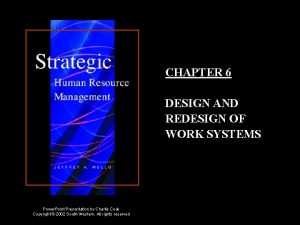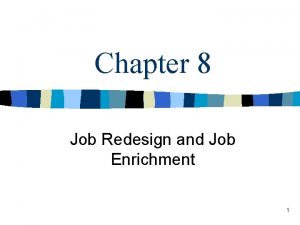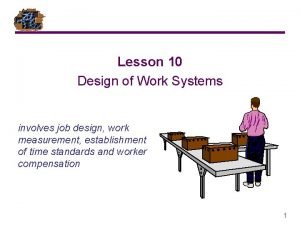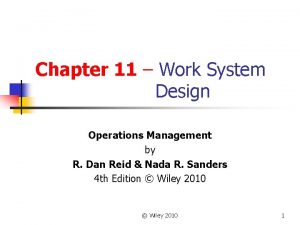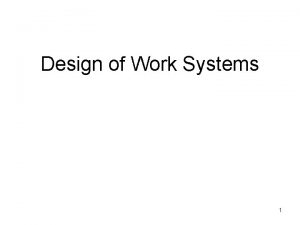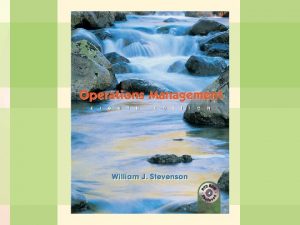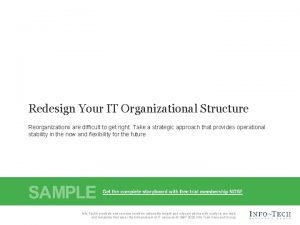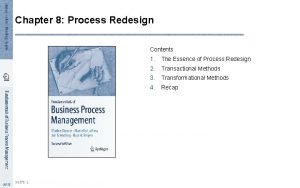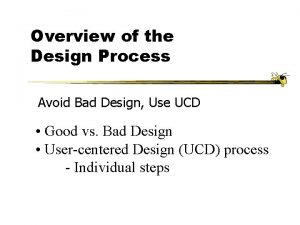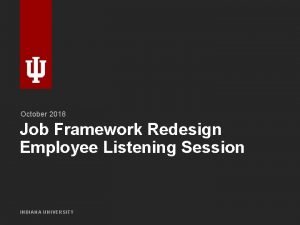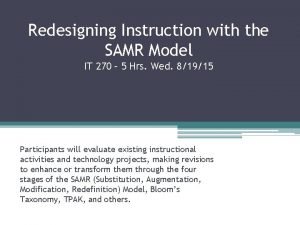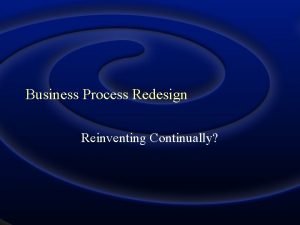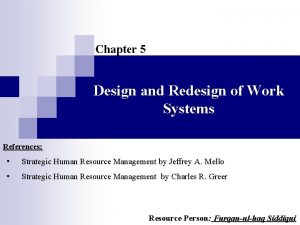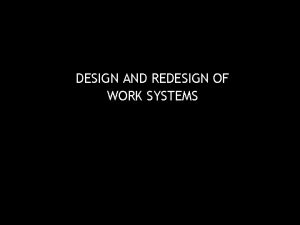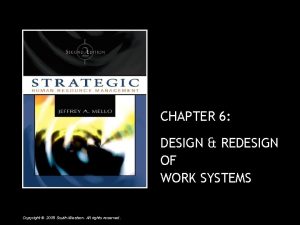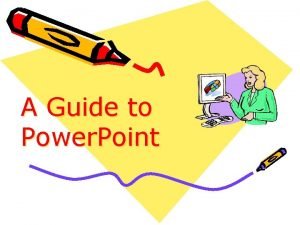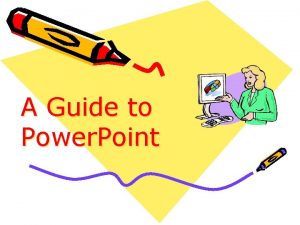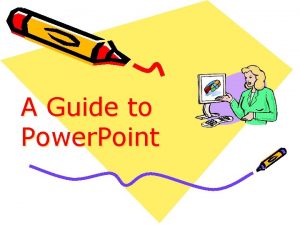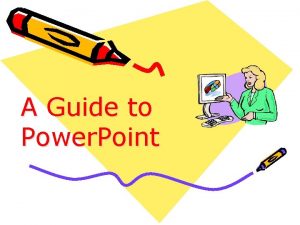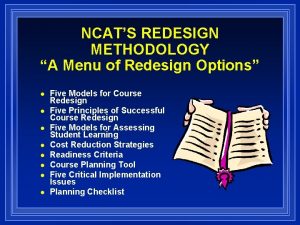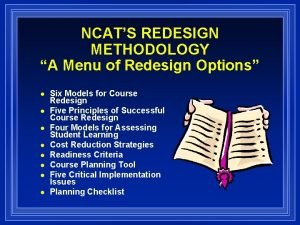DESIGN AND REDESIGN OF WORK SYSTEMS Power Point
























- Slides: 24

DESIGN AND REDESIGN OF WORK SYSTEMS Power. Point Presentation by Charlie Cook Copyright © 2002 South-Western. All rights reserved

Design of Work Systems Copyright © 2002 South-Western. All rights reserved. 6– 2

Design of Work Systems • Job Specialization – Creates jobs with very narrow task (activity) assignments. – Resulted in high efficiency, quickly achieved job competency, low training costs, but also created monotonous jobs. • Job Enlargement – An increase in task variety in an attempt to relieve boredom. • Job Rotation – Employees are moved across different specialized positions. Copyright © 2002 South-Western. All rights reserved. 6– 3

Design of Work Systems (cont’d) • Job Enrichment – Increasing the amount of responsibility for quality and productivity that employees have for their own work. • Vertical Loading – Is the reassignment of job responsibility formerly delegated to the supervisor to the employee. Copyright © 2002 South-Western. All rights reserved. 6– 4

Five Core Job Characteristics • Skill variety –The extent to which the work allows an employee to use a variety of acquired skills. • Task identity –The extent to which work allows an employee to complete a whole or identifiable piece of work. • Task significance –The extent to which the employee perceives that his/her work is important and meaningful to those in to those Copyright the © 2002 organization South-Western. All rightsor reserved. • Autonomy –The extent to which the employee is able to work and determine work procedure at her/his own discretion. • Feedback –The extent to which the work allows the employee to gain a sense of how well job responsibilities are being met. 6– 5

Copyright © 2002 South-Western. All rights reserved. 6– 6

What Workers Need • Changing demographics and life styles – Worker needs vary by age, gender, race, religion, physical abilities, sexual orientation, and marital and family status. • Employee needs for work/life balance – Workers are less committed to organizations today but also suffer from burnout and lower performance. • Employee needs representation (“voice”) – Workers want to be involved in work-related issues and expect the organization to listen to their concerns. • Employee concerns about safety in the workplace Copyright © 2002 South-Western. All rights reserved. 6– 7

How Jobs Interface with Other Jobs • Types of Task Interdependence – Pooled Interdependence • Individual employees work independently of each other in performing tasks but utilize coordination of their activities. – Sequential Interdependence • The work in process flows from one individual to another, where one individual depends on the timely completion of quality work for another coworker. – Reciprocal Interdependence • Workflow is not linear as in sequential interdependence but random. Work flow responds to immediate situation and employees have joint and shared responsibilities for the work. Copyright © 2002 South-Western. All rights reserved. 6– 8

Redesign of Work Systems • Current and future work systems are more broadly defined and more closely related to strategic choices made by management. • Workers are becoming more involved in the design and reengineering of their jobs. • Cross-function teams are strategically beneficial, but also create challenges in effectively managing their activities. Copyright © 2002 South-Western. All rights reserved. 6– 9

Understanding Change • The pressure to change is constant. • Barriers to change: – Change involves disrupting the status quo and may be met with resistance by both employees and managers. – Change comes with costs and the reallocation of resources. – Employees will resist change if they do not perceive a need to change work systems or see no benefits from change. – There is risk and uncertainty and no guarantee of increased results (performance, efficiency, or morale) in change Copyright © 2002 South-Western. All rights reserved. 6– 10

Managing Change • How to overcome resistance to change: – Promote and implement change so that it provides benefits to those impacted by the change. – Involve employees in the change process so that their commitment to the change process facilitates implementation of the change process. – Change is facilitated by open, two-way communication. Begin early before change decisions have yet been made. Reduce apprehension, dispel rumors, increase trust and acceptance of change by keeping employees informed and asking for their input. Copyright © 2002 South-Western. All rights reserved. 6– 11

Reading 6. 1: Restructuring Teams for Re-engineered Organizations • Reasons for using teams in organizations: – The complexity of many decisions in organizations that needs to be made make it unlikely that one individual will have all of the knowledge and information needed to make a good decision. – Teams can provide more “buy-in” (commitment) to decisions. – Managers believe that teams enhance motivation and productivity. – Teams facilitate the acquisition and sharing of information that is vital to organizational growth and flexibility. – Team can facilitate a variety of internal quality Copyright © 2002 South-Western. All rights reserved. 6– 12

Reading 6. 1: Restructuring Teams for Re-engineered Organizations • Problems with the use of teams: – Teams may fail without proper training and support. – Teams are often poorly integrated into the organization’s hierarchy. – Individuals often feel that their contributions to the team dilute their personal success and few teams have found effective means to deal with “freeloaders. ” – Teams are also usually not represented at top levels of organizations, sending a mixed message about their importance. Copyright © 2002 South-Western. All rights reserved. 6– 13

Reading 6. 1: Restructuring Teams for Re-engineered Organizations U. S. and Japanese Culture Differences Individualism versus Collectivism Conflict and Conformity Power and Authority Time Orientation Cultural and Demographic Homogeneity Copyright © 2002 South-Western. All rights reserved. 6– 14

Reading 6. 1: Restructuring Teams for Re-engineered Organizations Three Keys to Successful Teams Value and Endorse Dissent Encourage Fluidity of Membership Enable Teams to Make Decisions Copyright © 2002 South-Western. All rights reserved. 6– 15

Reading 6. 2: HRM Outsourcing: The Make or Buy Decision • Five competitive forces driving organizations to outsource HR activities: – – – Downsizing Rapid growth or decline Globalization Increased competition Restructuring Copyright © 2002 South-Western. All rights reserved. 6– 16

Reading 6. 2: HRM Outsourcing: The Make or Buy Decision • Operational Rationales for Outsourcing: – Size of the HR function in the organization. Small firms lack resources and large firms gain economies of scale. – Specialized HR expertise and objectivity; also reduced liability and risk for the employer through the use of outside specialists in legally sensitive HR areas. – Innovations and economies of scale in HRIS technology used by outside vendors that simplify transactions and reduce HR costs. – Time-sensitive issues that are better handled by outsourcing. Copyright © 2002 South-Western. All rights reserved. 6– 17

Major Factors Affecting HRM Technological Advancement Demographics and Diversity Strategic HRM Globalization Copyright © 2005 South-Western. All rights reserved. 1– 18

Exhibit 2 -1 Issues for Integrating New Technologies Copyright © 2005 South-Western. All rights reserved. 1– 19

Exhibit 2 -2 Impact of Technology on Organizations Copyright © 2005 South-Western. All rights reserved. 1– 20

Technology Challenges for HRM • Telecommuting • Employee surveillance & monitoring • e-HR • Ethical behavior Copyright © 2005 South-Western. All rights reserved. 1– 21

Telecommuting • Dramatic growth in number of Americans working from home – 3. 4 million in 1990 – 19. 6 million by beginning of 2000 Copyright © 2005 South-Western. All rights reserved. • Issues affecting success of telecommuting programs – Clear performance measurement system is key – Deciding which employees will be offered participation – Equipment expense – Some managers uncomfortable having direct reports away from office 1– 22

Employee Surveillance and Monitoring • More than 80% of large employers utilize monitoring technology – – – Internet usage E-mails Computer files Voice-mail Telephone usage • Under Electronic Communications Privacy Act (ECPA) employees have only limited privacy rights Copyright © 2005 South-Western. All rights reserved. 1– 23

E-HR • Opportunity to deliver transactional types of services online – Payroll – Employee benefits – Scheduling – Recruiting – Training – Career development Copyright © 2005 South-Western. All rights reserved. 1– 24
 Design and redesign of work systems
Design and redesign of work systems Triangle of power
Triangle of power Job enrichment example
Job enrichment example Informsu
Informsu Point point power
Point point power Job info 1 level 2 lesson 10
Job info 1 level 2 lesson 10 System design in operations management
System design in operations management Design of work systems
Design of work systems Design of work systems in operations management
Design of work systems in operations management Tdes school
Tdes school Getting organizational redesign right
Getting organizational redesign right Bh redesign
Bh redesign Pengertian job enrichment
Pengertian job enrichment Procurement process redesign
Procurement process redesign Redesign haifa
Redesign haifa Redesign orbit
Redesign orbit Principles of business process reengineering
Principles of business process reengineering Scina
Scina Redesign haifa
Redesign haifa Redesign bad honnef
Redesign bad honnef Job families examples
Job families examples Intranet redesign project plan
Intranet redesign project plan Technology allows for significant task redesign
Technology allows for significant task redesign Radical redesign of business processes
Radical redesign of business processes Power point presentation design west vancouver
Power point presentation design west vancouver
